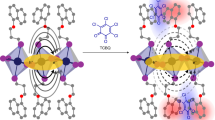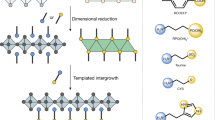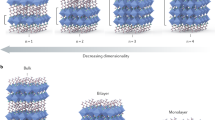Abstract
Semiconductor quantum-well structures and superlattices are key building blocks in modern optoelectronics, but it is difficult to simultaneously realize defect-free epitaxial growth while fine tuning the chemical composition, layer thickness and band structure of each layer to achieve the desired performance. Here we demonstrate the modulation of the electronic structure—and consequently the optical properties—of organic semiconducting building blocks that are incorporated between the layers of perovskites through a facile solution processing step. Self-aggregation of the conjugated organic molecules is suppressed by functionalization with sterically demanding groups and single crystalline organic–perovskite hybrid quantum wells (down to one-unit-cell thick) are obtained. The energy and charge transfers between adjacent organic and inorganic layers are shown to be fast and efficient, owing to the atomically flat interface and ultrasmall interlayer distance of the perovskite materials. The resulting two-dimensional hybrid perovskites are very stable due to protection given by the bulky hydrophobic organic groups.
This is a preview of subscription content, access via your institution
Access options
Access Nature and 54 other Nature Portfolio journals
Get Nature+, our best-value online-access subscription
$29.99 / 30 days
cancel any time
Subscribe to this journal
Receive 12 print issues and online access
$259.00 per year
only $21.58 per issue
Buy this article
- Purchase on Springer Link
- Instant access to full article PDF
Prices may be subject to local taxes which are calculated during checkout




Similar content being viewed by others
Data availability
Crystallographic data for the structures reported in this Article have been deposited at the Cambridge Crystallographic Data Centre under deposition numbers CCDC 1846391 [(4Tm)2PbI4], 1846392 [(BTm)2PbI4] and 1861843 [(2T)2PbI4]. Copies of the data can be obtained free of charge through https://www.ccdc.cam.ac.uk/structures/. All other data supporting the findings of this study are available within the Article and its Supplementary Information or from the corresponding author on reasonable request.
Change history
20 July 2020
A Correction to this paper has been published: https://doi.org/10.1038/s41557-020-0521-5
References
Levine, B. F. Quantum-well infrared photodetectors. J. Appl. Phys. 74, R1–R81 (1993).
Shuji, N. et al. InGaN-based multi-quantum-well-structure laser diodes. Jpn. J. Appl. Phys. 35, L74 (1996).
Hicks, L. D. & Dresselhaus, M. S. Effect of quantum-well structures on the thermoelectric figure of merit. Phys. Rev. B 47, 12727–12731 (1993).
Ishihara, T., Takahashi, J. & Goto, T. Exciton state in two-dimensional perovskite semiconductor (C10H21NH3)2PbI4. Solid State Commun. 69, 933–936 (1989).
Meresse, A. & Daoud, A. Bis(n-propylammonium) tetrachloroplumbate. Acta Crystallogr. C 45, 194–196 (1989).
Mitzi, D. B., Feild, C. A., Harrison, W. T. A. & Guloy, A. M. Conducting tin halides with a layered organic-based perovskite structure. Nature 369, 467–469 (1994).
Mitzi, D. B., Wang, S., Feild, C. A., Chess, C. A. & Guloy, A. M. Conducting layered organic-inorganic halides containing <110>-oriented perovskite sheets. Science 267, 1473–1476 (1995).
Papavassiliou, G. C. Three- and low-dimensional inorganic semiconductors. Prog. Solid State Chem. 25, 125–270 (1997).
Kagan, C. R., Mitzi, D. B. & Dimitrakopoulos, C. D. Organic–inorganic hybrid materials as semiconducting channels in thin-film field-effect transistors. Science 286, 945–947 (1999).
Borriello, I., Cantele, G. & Ninno, D. Ab initio investigation of hybrid organic-inorganic perovskites based on tin halides. Phys. Rev. B 77, 235214 (2008).
Lanty, G. et al. Room-temperature optical tunability and inhomogeneous broadening in 2D-layered organic–inorganic perovskite pseudobinary alloys. J. Phys. Chem. Lett. 5, 3958–3963 (2014).
Smith, I. C., Hoke, E. T., Solis-Ibarra, D., McGehee, M. D. & Karunadasa, H. I. A layered hybrid perovskite solar-cell absorber with enhanced moisture stability. Angew. Chem. Int. Ed. 53, 11232–11235 (2014).
Dou, L. T. et al. Atomically thin two-dimensional organic-inorganic hybrid perovskites. Science 349, 1518–1521 (2015).
Ha, S. T., Shen, C., Zhang, J. & Xiong, Q. H. Laser cooling of organic-inorganic lead halide perovskites. Nat. Photon. 10, 115–121 (2016).
Stoumpos, C. C. et al. Ruddlesden–Popper hybrid lead iodide perovskite 2D homologous semiconductors. Chem. Mater. 28, 2852–2867 (2016).
Tsai, H. et al. High-efficiency two-dimensional Ruddlesden–Popper perovskite solar cells. Nature 536, 312–316 (2016).
Wang, N. et al. Perovskite light-emitting diodes based on solution-processed self-organized multiple quantum wells. Nat. Photon. 10, 699–704 (2016).
Yuan, M. et al. Perovskite energy funnels for efficient light-emitting diodes. Nat. Nanotechnol. 11, 872–877 (2016).
Mao, L. L. et al. Tunable white-light emission in single-cation-templated three-layered 2D perovskites (CH3CH2NH3)4Pb3Br10–xClx. J. Am. Chem. Soc. 139, 11956–11963 (2017).
Proppe, A. H. et al. Synthetic control over quantum well width distribution and carrier migration in low-dimensional perovskite photovoltaics. J. Am. Chem. Soc. 140, 2890–2896 (2018).
Shi, E. et al. Two-dimensional halide perovskite nanomaterials and heterostructures. Chem. Soc. Rev. 47, 6046–6072 (2018).
Mitzi, D. B. Templating and structural engineering in organic–inorganic perovskites. J. Chem. Soc. Dalton Trans. 0, 1–12 (2001).
Saparov, B. & Mitzi, D. B. Organic–inorganic perovskites: structural versatility for functional materials design. Chem. Rev. 116, 4558–4596 (2016).
Braun, M., Tuffentsammer, W., Wachtel, H. & Wolf, H. C. Pyrene as emitting chromophore in organic-inorganic lead halide-based layered perovskites with different halides. Chem. Phys. Lett. 307, 373–378 (1999).
Chondroudis, K. & Mitzi, D. B. Electroluminescence from an organic-inorganic perovskite incorporating a quaterthiophene dye within lead halide perovskite layers. Chem. Mater. 11, 3028–3030 (1999).
Mitzi, D. B., Chondroudis, K. & Kagan, C. R. Design, structure, and optical properties of organic-inorganic perovskites containing an oligothiophene chromophore. Inorg. Chem. 38, 6246–6256 (1999).
Takeoka, Y., Asai, K., Rikukawa, M. & Sanui, K. Incorporation of conjugated polydiacetylene systems into organic–inorganic quantum-well structures. Chem. Commun. 2592–2593 (2001).
Zhu, X. H. et al. Effect of mono- versus di-ammonium cation of 2,2′-bithiophene derivatives on the structure of organic–inorganic hybrid materials based on iodo metallates. Inorg. Chem. 42, 5330–5339 (2003).
Ema, K., Inomata, M., Kato, Y., Kunugita, H. & Era, M. Nearly perfect triplet-triplet energy transfer from wannier excitons to naphthalene in organic–inorganic hybrid quantum-well materials. Phys. Rev. Lett. 100, 257401 (2008).
Era, M., Kobayashi, T., Sakaguchi, K., Tsukamoto, E. & Oishi, Y. Electric conduction of PbBr-based layered perovskite organic–inorganic superlattice having carbazole chromophore-linked ammonium molecule as an organic layer. Org. Electron. 14, 1313–1317 (2013).
Papavassiliou, G. C., Mousdis, G. A., Pagona, G., Karousis, N. & Vidali, M.-S. Room temperature enhanced blue-green, yellow-orange and red phosphorescence from some compounds of the type (CH3NH3)n−1(1-naphthylmethyl ammonium)2Pbn(ClxBr1–x)3n+1 (with n = 1, 2 and 0 ≤ x ≤1) and related observations from similar compounds. J. Lumin. 149, 287–291 (2014).
Evans, H. A. et al. (TTF)Pb2I5: a radical cation-stabilized hybrid lead iodide with synergistic optoelectronic signatures. Chem. Mater. 28, 3607–3611 (2016).
Cortecchia, D., Soci, C., Cametti, M., Petrozza, A. & Marti-Rujas, J. Crystal engineering of a two-dimensional lead-free perovskite with functional organic cations by second-sphere coordination. Chempluschem 82, 681–685 (2017).
Du, K. Z. et al. Two-dimensional lead(ii) halide-based hybrid perovskites templated by acene alkylamines: crystal structures, optical properties, and piezoelectricity. Inorg. Chem. 56, 9291–9302 (2017).
Ortiz-Cervantes, C., Román-Román, P. I., Vazquez-Chavez, J., Hernández-Rodríguez, M. & Solis-Ibarra, D. Thousand-fold conductivity increase in 2D perovskites by polydiacetylene incorporation and doping. Angew. Chem. Int. Ed. 57, 13882–13886 (2018).
Passarelli, J. V. et al. Enhanced out-of-plane conductivity and photovoltaic performance in n = 1 layered perovskites through organic cation design. J. Am. Chem. Soc. 140, 7313–7323 (2018).
Mitzi, D. B. Synthesis, crystal structure, and optical and thermal properties of (C4H9NH3)2MI4 (M = Ge, Sn, Pb). Chem. Mater. 8, 791–800 (1996).
Billing, D. G. & Lemmerer, A. Synthesis, characterization and phase transitions in the inorganic-organic layered perovskite-type hybrids [(CnH2n+1NH3)2PbI4], n = 4, 5 and 6. Acta Crystallogr. B 63, 735–747 (2007).
Liao, W.-Q. et al. A lead-halide perovskite molecular ferroelectric semiconductor. Nat. Commun. 6, 7338 (2015).
Niu, W., Eiden, A., Vijaya Prakash, G. & Baumberg, J. J. Exfoliation of self-assembled 2D organic–inorganic perovskite semiconductors. Appl. Phys. Lett. 104, 171111 (2014).
Straus, D. B. & Kagan, C. R. Electrons, excitons, and phonons in two-dimensional hybrid perovskites: connecting structural, optical, and electronic properties. J. Phys. Chem. Lett. 9, 1434–1447 (2018).
Zhu, T. et al. Highly mobile charge-transfer excitons in two-dimensional WS2/tetracene heterostructures. Sci. Adv. 4, eaao3104 (2018).
Blum, V. et al. Ab initio molecular simulations with numeric atom-centered orbitals. Comput. Phys. Commun. 180, 2175–2196 (2009).
Levchenko, S.V. et al. Hybrid functionals for large periodic systems in an all-electron, numeric atom-centered basis framework. Comput. Phys. Commun. 192, 60–69 (2015).
Huhn, W.P. & Blum, V. One-hundred-three compound band-structure benchmark of post-self-consistent spin-orbit coupling treatments in density functional theory. Phys. Rev. Mater. 1, 033803 (2017).
Liu, C. et al. Tunable semiconductors: control over carrier states and excitations in layered hybrid organic-inorganic perovskites. Phys. Rev. Lett. 121, 146401 (2018).
Leveillee, J. et al. Influence of π-conjugated cations and halogen substitution on the optoelectronic and excitonic properties of layered hybrid perovskites. Phys. Rev. Mater. 2, 105406 (2018).
Acknowledgements
This work is supported by the US Office of Naval Research (award no. N00014-19-1-2296 to L.D.; programme managers: P. Armistead and J. Parker), the Davidson School of Chemical Engineering, College of Engineering and the Birck Nanotechnology Center of Purdue University. L.H., J.S and S.D acknowledge the support from US Department of Energy, Office of Basic Energy Sciences through award no. DE-SC0016356. B.W.B. acknowledges the support from US Air Force Office of Scientific Research (award no. FA9550-15-1-0449). The work on the single-crystal X-ray diffractions was supported by the National Science Foundation (award no. CHE 1625543). Work by V.B. and R.S. was financially supported by the National Science Foundation under award no. DMR-1729297. An award of computer time was provided by the Innovative and Novel Computational Impact on Theory and Experiment Program. This research used resources of the Argonne Leadership Computing Facility, which is a Department of Energy Office of Science User Facility supported under contract no. DE-AC02-06CH11357. S.J. thanks the Deutsche Forschungsgemeinschaft (German Research Foundation) for a postdoctoral fellowship (award no. 393196393). Transmission electron microscopy work is supported by the Center for High-resolution Electron Microscopy at ShanghaiTech University. The authors thank G. Wiederrecht and R. Schaller for assistance in the streak camera measurements; D. Zemlyanov for the ultraviolet photoelectron spectroscopy measurements; D. Kumar for grazing-incidence wide-angle X-ray scattering data processing; J. Mei for cyclic voltammetry measurements; and S. Beaudoin for atomic force microscopy measurements.
Author information
Authors and Affiliations
Contributions
L.D. conceived the idea and supervised the project. Y.G. carried out the materials synthesis, structural characterizations and data analysis. E.S. synthesized the nanocrystals. J.S., S.D. and L.H. carried out the ultrafast spectroscopy measurements and data analysis. S.B.S. and B.S. performed molecular dynamics simulations. C.L., B.Y. and Y.Y. carried out high-resolution transmission electron microscopy measurements and data analysis. A.L.-P. and C.Z. carried out grazing-incidence wide-angle X-ray scattering measurements. P.Y., P.L., R.S., S.J. and V.B. performed density functional theory simulations. M.Z. collected single-crystal X-ray data and solved and refined the crystal structures. B.W.B. provided characterization facilities and participated data analysis and manuscript preparation. Y.G. and L.D. wrote the manuscript. All authors discussed the results and revised the manuscript.
Corresponding author
Ethics declarations
Competing interests
The authors declare no competing interests.
Additional information
Publisher’s note Springer Nature remains neutral with regard to jurisdictional claims in published maps and institutional affiliations.
Supplementary information
Supplementary Information
Supplementary Figs., tables, methods and 1H, 13C NMR and FT-IR spectra.
Crystallographic data
CIF for compound (2T)2PbI4; CCDC reference: 1861843.
Crystallographic data
CIF for compound (4Tm)2PbI4; CCDC reference: 1846391.
Crystallographic data
CIF for compound (BTm)2PbI4; CCDC reference: 1846392.
Video
Water immersion test.
Rights and permissions
About this article
Cite this article
Gao, Y., Shi, E., Deng, S. et al. Molecular engineering of organic–inorganic hybrid perovskites quantum wells. Nat. Chem. 11, 1151–1157 (2019). https://doi.org/10.1038/s41557-019-0354-2
Received:
Accepted:
Published:
Issue Date:
DOI: https://doi.org/10.1038/s41557-019-0354-2
This article is cited by
-
Growth of millimeter-sized 2D metal iodide crystals induced by ion-specific preference at water-air interfaces
Nature Communications (2024)
-
Harnessing strong aromatic conjugation in low-dimensional perovskite heterojunctions for high-performance photovoltaic devices
Nature Communications (2024)
-
Large exchange-driven intrinsic circular dichroism of a chiral 2D hybrid perovskite
Nature Communications (2024)
-
Two-dimensional lead halide perovskite lateral homojunctions enabled by phase pinning
Nature Communications (2024)
-
Thickness control of organic semiconductor-incorporated perovskites
Nature Chemistry (2023)



